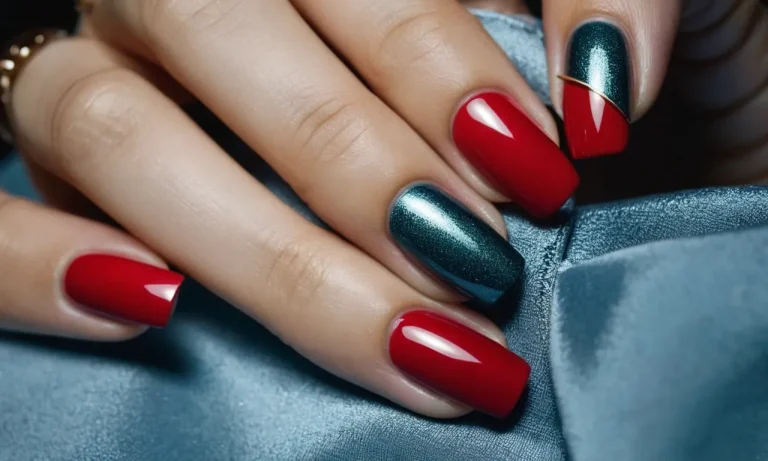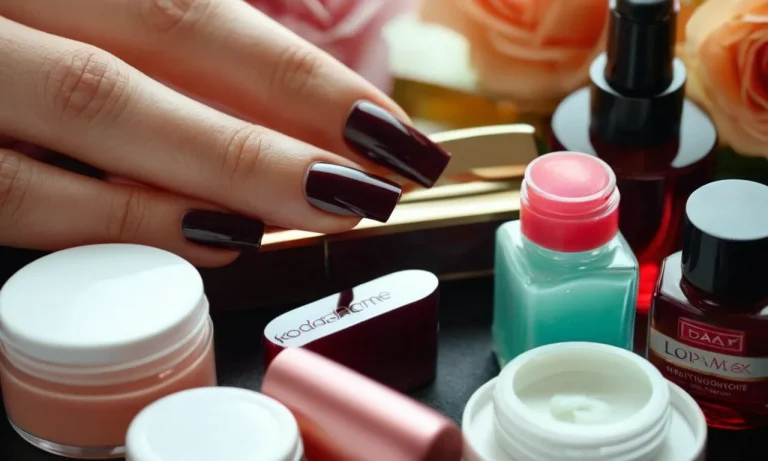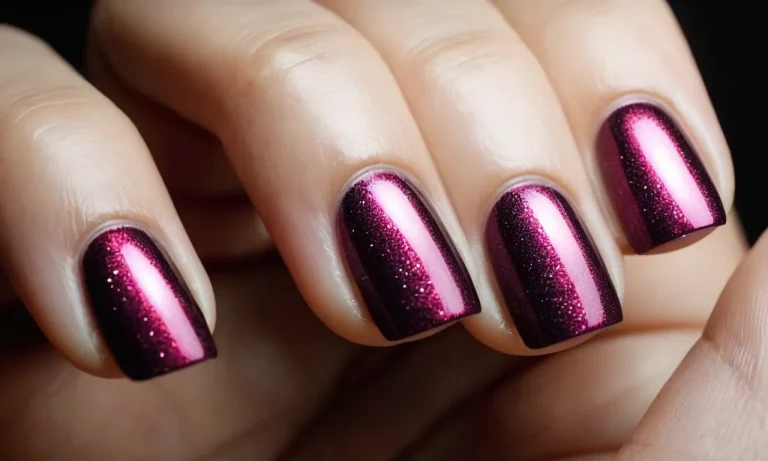Can Clear Nail Polish Treat Ringworm? A Comprehensive Guide
Ringworm is an itchy, contagious fungal infection that can affect the skin, scalp, feet or nails. If you’re looking for home remedies, you may wonder: can clear nail polish help treat ringworm? Here’s a quick answer: applying clear nail polish directly on ringworm lesions can potentially suffocate the fungal infection.
However, research on using nail polish for ringworm is limited and it should not replace antifungal medications prescribed by your doctor.
In this comprehensive guide, we’ll dive deep into the uses, effectiveness, safety concerns, and proper usage techniques for using clear nail polish on ringworm. We’ll also explore other home remedies like topical creams, oral medications, essential oils, apple cider vinegar, and more.
Read on to get the full scoop!
What Is Ringworm and What Causes It?
Definition and symptoms
Ringworm, also known as tinea, is a fungal infection of the skin that causes a red, circular, itchy rash. Despite its name, ringworm is not caused by worms but by various types of fungi called dermatophytes that live on the dead tissues of the skin, hair, and nails.
When ringworm affects the body, arms, legs, or face, it is medically known as tinea corporis. On the scalp, it is called tinea capitis, while on the feet it is called tinea pedis or athlete’s foot. Some common symptoms of ringworm include:
- Red, circular rash with clearer skin in the middle
- Itching, burning, or stinging of affected area
- Scaly, crusted rash on the scalp
- Hair loss or breakage where scalp is infected
- Dry, flaky skin on feet with athlete’s foot
Ringworm often starts as a small red spot that grows larger over days or weeks, forming the distinctive ring shape up to a few inches in diameter. The rash is usually not painful but can be quite itchy or irritating.
Without treatment, ringworm can last for months and continue to spread to other parts of the body.
Causes and risk factors
Ringworm is caused by several types of fungi in the Trichophyton and Microsporum genera that live naturally on the dead tissues of hair, skin, and nails. It spreads through direct skin-to-skin contact with an infected person or animal and by sharing contaminated items such as clothing, brushes, bedding, and shower surfaces.
Because ringworm thrives in warm, moist environments, activities that promote sweat increase risk. Other factors that raise risk include:
- Warm, humid climates
- Poor hygiene and crowded living quarters
- Contact sports like wrestling or football
- Using public showers or pools
- Having a weak immune system
- Owning a pet with ringworm
Children and teenagers are most prone to infection because they often have close physical contact and share personal items. Adults whose immune systems are compromised, such as people living with HIV/AIDS, are also at higher risk.
Diagnosis
Ringworm is often diagnosed simply by examining the appearance and location of the rash. A doctor may use a special ultraviolet light called a Wood’s lamp to check for ringworm which will glow bright green under the light.
They may also take skin scrapings or hair samples to view under a microscope or have lab tests done to identify the specific fungus causing infection.
Distinctive features that help diagnose ringworm are the circular shape with central clearing and location on body sites prone to infection. Doctors can usually distinguish ringworm from other rashes like psoriasis, eczema, or cellulitis based on the appearance and distribution of lesions.
Can Clear Nail Polish Treat Ringworm Effectively?
The theory behind using nail polish
The idea behind using clear nail polish to treat ringworm is that the acrylic ingredients in the polish essentially suffocate and starve the fungal infection. When applied to affected skin, the polish creates an airtight barrier that prevents the fungus from breathing and spreading.
Some also believe the chemicals in the polish have antifungal properties that kill off the infection.
Research and evidence on effectiveness
There is limited research on using nail polish to treat ringworm. One small study found applying nail polish once a day was as effective as a topical antifungal cream. However, more robust studies are needed.
Anecdotal evidence online shows mixed results. Some people report the nail polish quickly resolved their ringworm, while others saw no improvement. Effectiveness likely depends on factors like the severity of infection and consistency of application.
Potential benefits
Here are some potential awesome benefits of trying clear nail polish for ringworm treatment:
- Low cost and easily accessible – no prescription needed
- Convenient to apply at home
- May help contain fungal spread by sealing affected area
- Some report rapid improvement in rash and itching
Limitations and concerns
Using nail polish does come with some important limitations and risks:
- Lack of robust clinical evidence showing efficacy
- Can cause skin irritation, redness, peeling in some people
- Doesn’t penetrate skin to kill fungus at root
- Risk of trapping fungus if not fully cured before removing polish
American Academy of Dermatology don’t recommend nail polish as a first line treatment. Professional antifungal creams or oral medications demonstrate higher success rates in studies. As with any home remedy, effectiveness seems to vary by individual.
Proper Usage Techniques and Safety Tips
Methods of application
When using clear nail polish to treat ringworm, it is important to apply it correctly for maximum effectiveness. Here are some recommended application techniques:
- Clean and dry the affected area thoroughly before applying the polish. Make sure there is no moisturizer, oil, or debris on the skin.
- Use a cotton ball or pad to apply a thin layer of polish directly onto the ringworm patch. Do not apply too much.
- Allow the polish to dry completely, about 5-10 minutes, before closing the bottle. This prevents contamination.
- Apply 1-2 additional thin layers, allowing each coat to dry between applications. Too many thick layers may cause peeling.
- Cover the entire patch with polish, just beyond the edges. This helps seal off the infection.
- Be careful not to get polish on unaffected areas. Use a cotton swab to clean up any mistakes.
Recommended duration
Most sources recommend leaving the clear nail polish over the ringworm for at least 7-10 days. This allows enough time for the antifungal properties in the polish to take effect and start eliminating the infection. Some tips include:
- Keep the polish coating intact for the entire duration, reapplying if needed. Don’t peel it off prematurely.
- Look for signs of improvement, like reduced redness, itching, and patch size. This indicates it’s working.
- After 7-10 days, you can remove the polish with nail polish remover. See if the ringworm looks fully healed.
- If not fully resolved, reapply the polish for another 7 days. Most cases clear within 2-3 applications.
- For persistent infections, see a dermatologist if it lasts over 4 weeks despite polish use.
Precautions to take
While generally safe when used properly, there are some precautions to take when treating ringworm with clear nail polish:
- Do not use if you have an allergy or sensitivity to nail polish or its ingredients.
- Avoid contact with eyes, nostrils, mouth, genitals, wounds, etc. Only apply to ringworm patches.
- Do not use on ringworm located on the scalp or feet (athlete’s foot). These need oral antifungals.
- Watch for redness, swelling, oozing, increased itch – signs of reaction. Remove polish if this occurs.
- Keep polish away from heat, flames, sparks – it’s flammable until fully dried.
- Use in well-ventilated area and don’t inhale fumes directly.
- Keep bottle tightly closed and store out of reach of children.
When to avoid use
While clear nail polish is an easy home remedy for many, there are some cases when it should be avoided:
- Pregnant or breastfeeding women, as effects are unknown.
- Infants and young children under age 2.
- Individuals with sensitive skin or dermatitis.
- If the ringworm covers a large surface area of the body.
- If the infection persists for over 4 weeks without improvement.
- On the scalp, nails, feet, groin or face – seek medical treatment instead.
- If along with other symptoms like pain, oozing, fever – could indicate a secondary infection.
In these situations, it is best to see a doctor for proper diagnosis and antifungal prescription treatment to clear up the ringworm infection safely and effectively.
Other Home Remedies and OTC Treatments
Topical Antifungal Creams
Over-the-counter (OTC) topical antifungal creams containing ingredients like miconazole, clotrimazole, or terbinafine can be effective at treating ringworm (American Academy of Dermatology). These OTC antifungals help stop the growth of fungus locally on the skin and come in formats like creams, gels, sprays, powders, and solutions.
Using an OTC antifungal for 2-4 weeks as directed can clear up many mild to moderate cases of ringworm. However, prescription strength topical antifungals may be needed for more stubborn infections.
Oral Antifungal Medications
For severe, widespread, or difficult-to-treat ringworm infections, oral antifungal medications may be prescribed by a doctor. Commonly prescribed oral antifungals for ringworm include terbinafine, itraconazole, fluconazole, and griseofulvin (Healthline).
These work throughout the whole body to eliminate fungal infections. Oral meds can take from 2-12 weeks to fully clear ringworm but are very effective when topical treatment fails. However, they may come with more potential side effects like nausea, diarrhea, headaches, and liver damage in some cases.
Essential Oils
Certain antifungal essential oils like tea tree oil, coconut oil, jojoba oil, lavender oil, clove oil, and thyme oil show promising effects against ringworm fungus (PubMed study). They are best used topically on small areas of infected skin, applying a few drops of oil and massaging gently.
Repeated application may help clear stubborn cases over a few weeks. However, rashes may worsen with extended use of potent oils for some people. Essential oils should always be diluted properly before applying to prevent irritation.
Apple Cider Vinegar
The acetic acid in apple cider vinegar (ACV) has antifungal properties that may inhibit the growth of ringworm (MNT). Anecdotal evidence suggests that applying diluted ACV with a cotton ball on ringworm patches for 30 minutes daily may provide relief.
The vinegar helps lower the skin pH level to prevent fungus spread. Repeat for a week or two to see improvement. However, ACV can cause burns or rashes on sensitive skin, so caution must be taken.
Tea Tree Oil
Tea tree oil contains powerful antifungal compounds called terpenes that penetrate deep into the skin to eradicate ringworm fungus (NCBI study). In a study comparing various essential oils against ringworm, tea tree oil showed the strongest antifungal activity.
Using an over-the-counter preparation containing 10% tea tree oil seems to work better than 1% formulations. Apply a few drops on clean skin with a cotton swab twice daily for 2-4 weeks. Avoid using it undiluted as it may cause skin irritation.
Coconut Oil
The lauric, capric, and caprylic acids in coconut oil have antimicrobial effects that can suppress fungal infections like ringworm (NCBI research). Simply rub a little extra virgin coconut oil gently over ringworm lesions twice daily.
It moisturizes the skin while relieving inflammation and itchiness. Using for a month may significantly improve symptoms. Being naturally soothing, coconut oil suits even sensitive skin. It can enhance the efficacy of antifungal creams too.
Seeking Professional Medical Treatment
When to see a doctor
It’s recommended to consult a dermatologist or primary care physician if:
- The rash spreads quickly or lasts more than four weeks
- Symptoms worsen or don’t improve with over-the-counter antifungal creams
- The rash is widespread over large areas of the body
- You have a weakened immune system due to medication, pregnancy, or other conditions
Seeking timely medical care can help mitigate complications and reduce recovery time. Dermatologists have specialized expertise in diagnosing and treating skin conditions like ringworm.
Prescription medications
For moderate to severe ringworm, doctors may prescribe oral antifungal medications like terbinafine or itraconazole. These systemic drugs spread through the bloodstream to treat fungal infections throughout the body.
Oral pills or topical solutions are continued typically for 2-4 weeks or longer as advised by your physician. These powerful prescription antifungals can cause side effects like nausea, diarrhea, headache or liver damage in some people.
Phototherapy
Photodynamic therapy is an emerging treatment using a photosensitizing chemical and light to eliminate ringworm-causing fungi. As per an Italian study, antifungal photodynamic therapy achieved a 92.5% clearance rate within 12 weeks.
More clinical research is underway on the efficacy and safety profile of anti-fungal phototherapy.
Preventing spread and recurrence
Doctors advise proper hygiene and sanitization habits to avoid reinfection and transmission such as:
- Avoid sharing combs, towels, clothes or other personal items
- Wash bath towels in hot water regularly
- Clean showers, sinks and bathrooms with disinfectants
- Trim nails short and smooth sharp edges
- Apply antifungal powder in socks and shoes
By following your physician’s treatment plan diligently and taking preventive measures, you can conquer ringworm decisively and lower recurrence risk over time.
Conclusion
While using clear nail polish on ringworm may help smother lesions, research on its effectiveness is limited. Consult a dermatologist before trying it, stick to proper usage guidelines, and avoid using polish as a standalone treatment.
With prescription antifungals, good hygiene, and avoiding reinfection, you can fully cure ringworm. See a doctor if symptoms persist or worsen.







